Tour to iSimangaliso Wetlands Park (UNESCO site) and Lake St Lucia

Take Off
Jörgen Wennberg
Wed 15 Nov 2017 11:47
We hard hardly come in to South Africa that we went on our first safari tour. Before leaving the marina the next morning on our arrival, we made sure to secure the boat properly to the pontoon as bad winds were predicted to come over Richard’s Bay during the afternoon. This is why we were extremely glad too to have managed to come into the marina before the bad weather hits Richard’s Bay. Richard’s Bay lies in the region of KwaZulu-Natal and is part of Zululand. We drove further North along the coast towards Mozambique and our destination lies in a county called Elephant Coast. Located on the East coast of South Africa, the Zulu Kingdom borders the Eastern Cape in the South and Mozambique in the North. Lapped by the warm waters of the Indian Ocean and through its tranquil midlands and game-filled wilderness areas to the majestic peaks of the Drakensberg mountain range, KwaZulu-Natal, popularly known as the Zulu Kingdom - is a region blessed with astonishing natural beauty and diversity. KwaZulu-Natal covers more than 94000 km2 and derives its name from the Zulu meaning of the word “KwaZulu”, being the “dwelling place of the Zulu” and the name “Rio de Natal”, given to the port of Durban by early Portuguese discoverers. It was renamed d’Urban in 1835, with the official spelling eventually becoming Durban. We came into this charming little hotel where we were served breakfast before going on our safari tour. A painting of the Big 5: Elephant, Rhino, Lion, Buffalo and the Guepard. Why they are called the Big 5 is not due to their size as one should have thought, then the giraffe would be among these too. These animals counted as the Big 5 is due to hunting. When hunters (bad people…) hunt these animals, if they miss or do not manage to kill the animal, the animal will get to the hunter and will not leave his target until he is done with the hunter. In other words these 5 animals are the most challenging animals to kill for a hunter. Unfortunately hunting is still going on...  We visited the iSimangaliso Wetlands Park is a UNESCO World Heritage Site nearby Cape Vidal. It comprises one of the largest protected areas in South Africa and offers exceptional biodiversity, superlative beauty and unique ecology from the Mozambican border in the North to Mapelane South of the Lake St.Lucia. The word isimangaliso means "a miracle" or "something wondrous” in Zulu. The name came as a result of Shaka's subject having been sent to the land of the Tsonga. When he came back he described the beauty that he saw as a miracle. It was here that the White Rhino was saved from extinction. A vast eco-sensitive wilderness area incorporating a pristine marine reserve, lakes and coastal dune forest. This bush buck was just by the road, however you had to have a guide’s eye to see it among the bushes.  The rest of the photos here under until the hippos are unfortunately not our photos. They were lost. So we borrowed some. We saw a white rhino which is very rare!  A waterbuck (white ring back). The waterbuck’s habitat is in Africa near permanent sources of water. Waterbuck gets dehydrated more than other varieties of antilope, so staying near water is a priority. The waterbuck can weigh up to 350 kilos!  Dung beetle : amazing creatures living on other animals' poos! 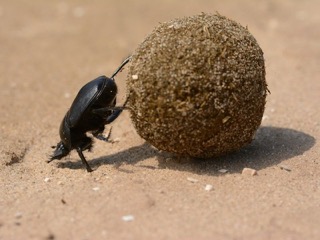  Yellow billed kite  Grey heron  We ended the tour by seeing black rhinos. What is the difference between a white and a black rhino? Both species are found in sub-Saharan Africa and look similar to one another, but the major difference is the shape of their mouths. Black rhinos has a pointed lip which they use to pick fruit from branches and select leaves from twigs; white rhinos have a flat, wide lip to graze on grass.   Wild Beest! There is also a group of animals called the Ugly 5…. which are the Gnu, the Warthog, the Wild Beest and 2 more... 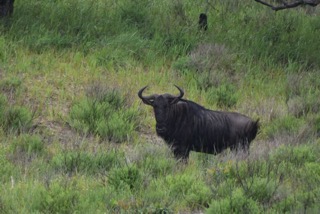  We came back to the lovely little hotel and had lunch before heading to our next tour on Lake St Lucia.   We boarded a big boat on Lake St Lucia and motored along the shores where we saw all these hippos. Great picture of this one looking straight into the camera .    We had an excellent guide telling us all about hippos and how they live. Here is a skeleton of hippo head. 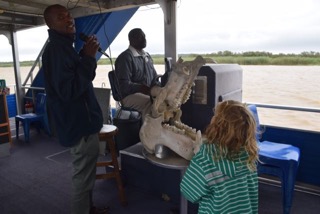 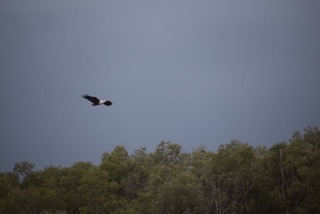  Inez is pointing out a big bird of prey, landing just right above our heads.   The predicted wind has now started to pick up and it is now really really windy. We see the hippos hiding in the mangrove …  ...and so do we in the boat.   A lovely tour together with Ken & Eileen on Aurora, Bob & Karen & Sam on Lexington and Barbara & Jeff on Altair.  Some pieces of art by the ferry terminal.   Inez bought a hippo  Louise bought these hard shells called “Monkey Nut” coming from the monkey orange strychnos spinosa. They get their name from the animals eating it: baboon, monkey, bush pig and eland. They are being carved with the design of the animals from the Big 5 by this boy to the right. The fruit in this shell is poisonous when just growing. As it ripes, the fruit becomes eatable and the shell so hard that you can carve in it. They are then made as a lamp, holding candles.  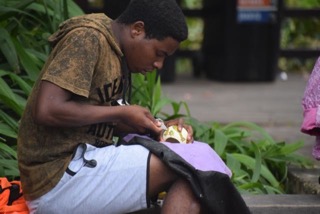 You never know who and what you can meet by crossing the roads here in South Africa.  |